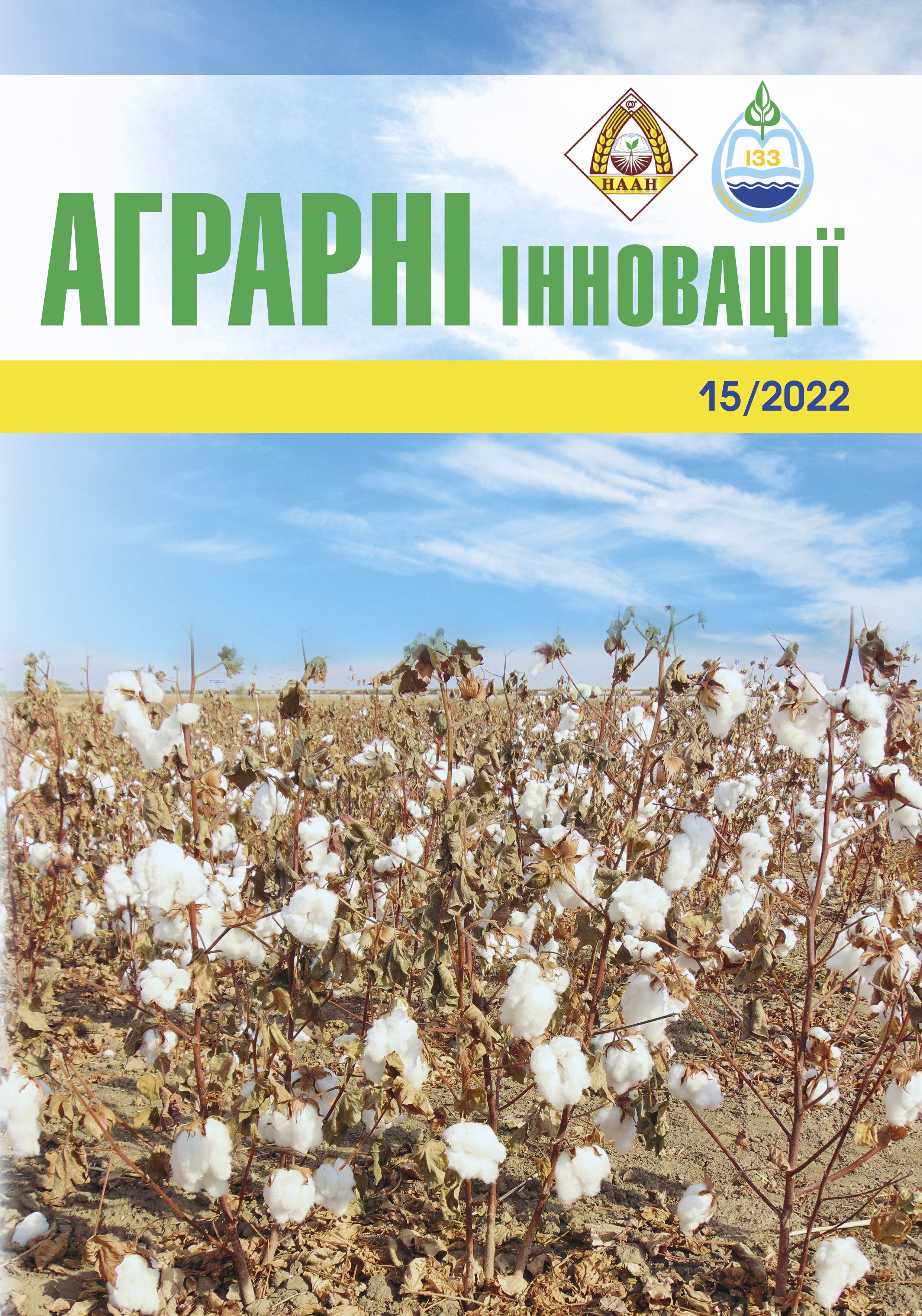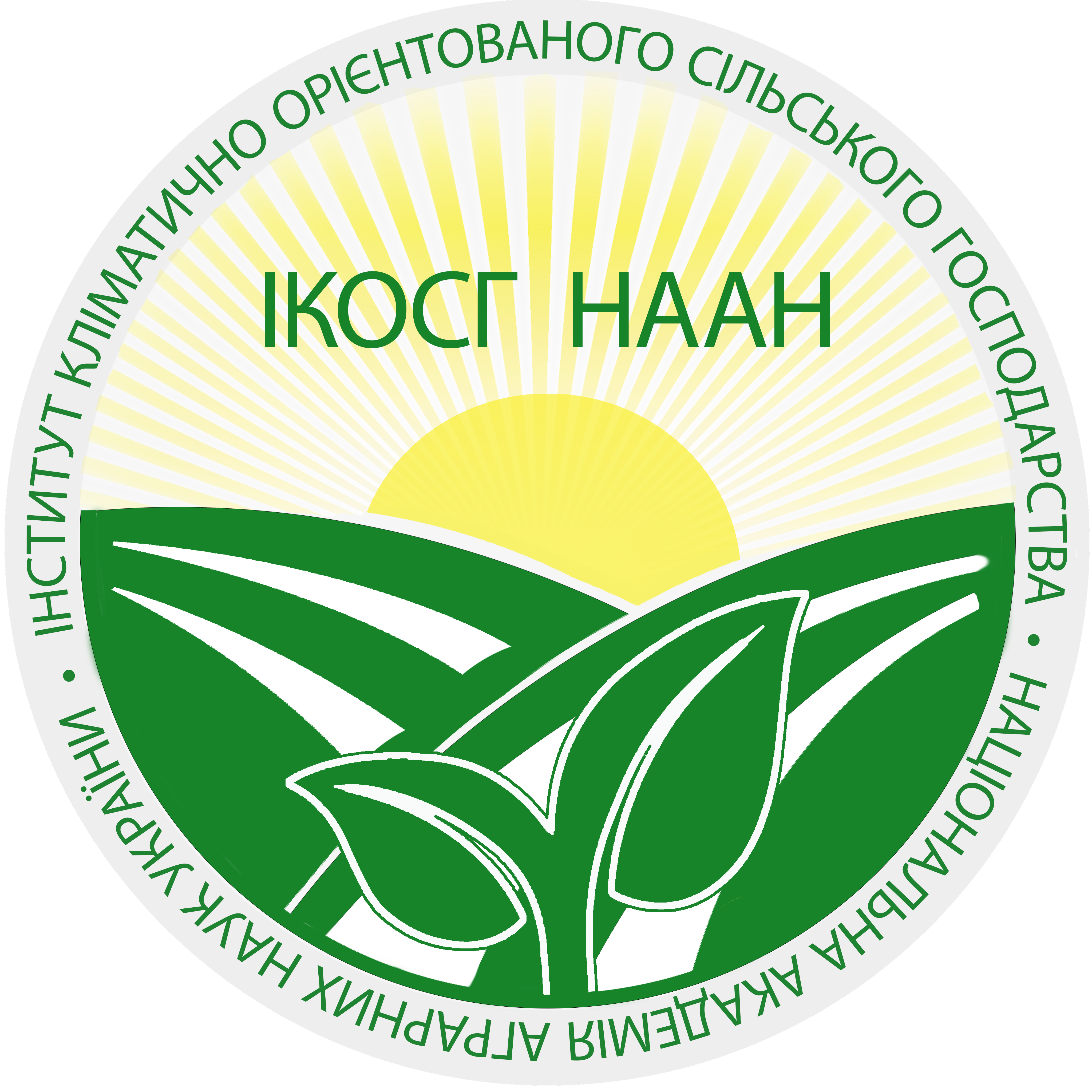Оцінка посухостійкості популяцій люцерни за насіннєвого використання в рік сівби
Анотація
Мета. Провести оцінку реакції сортів і популяцій люцерни за різних середовищ та визначити кращі не тільки за посухостійкістю, а й за продуктивністю в умовах стресу з подальшим використанням їх в селекційному процесі. Методи. Дослідження проводили в Інституті зрошуваного землеробства НААН (Україна, м. Херсон, сел. Наддніпрянське, 46°44'50.1"N 32°42'30.0"E), що розташований на Інгулецькому зрошуваному масиві, протягом 2017‒2019 рр. у польових умовах. Об’єктом вивчення були сорти та популяції люцерни. Продуктивність та посухостійкість визначали з використанням індексів: середня урожайність (MP), індекс сприятливості до посухи (SSI), індекс толерантності до посухи (TOL), індекс стабільності урожаю (YSI), індекс урожайності (YI), індекс толерантності до стресу (STI), середня геометрична (пропорційна) урожайність (GMP), індекс відносної стійкості до посухи (RDI), індекс посухостійкості (DI), індекс схильності до стресу (SSPI), модифіковані індекси толерантності до стресу (M1STI, M2STI, MSTI), індекс абіотичної толерантності (ATI), гармонійна середня продуктивність (HMP) та індекс стійкості до стресу (ISR). Результати. Погодні умови за роки проведення досліджень різнилися як за температурним режимом, так і за кількістю та характером опадів, що дало можливість проаналізувати сорти та популяції люцерни за насіннєвою продуктивністю на стійкість до стресових (посушливих) умов вирощування. Найнижчими індексами чутливості до посухи (SSI) характеризувалися популяції M.g. / ЦП-11, Ж. / ЦП-11 та Т. / Емерауде з показниками 0,83, 0,85 і 0,88. Найвищий YSI мали дві популяції: Ж. / ЦП-11 та M.g. / ЦП-11 з показниками 0,41–0,42. Вони характеризувалися і високою відносною посухостійкістю (RDI) з показниками індексу 1,35 й 1,40, відповідно. Крім того, популяція M.g. / ЦП-11 характеризувалася високими значеннями ряду індексів: урожайності (YI) – 159,3, толерантності до стресу (STI) – 0,55, середньої геометричної урожайності (GMP) – 237, посухостійкості (DI) – 0,68, гармонійної продуктивності (HMP) – 217, стійкості до стресу (ISR) – 468 та модифікованими індексами толерантності до стресу (M1STI, M2STI й MSTI) – 0,71, 1,40 й 1,00, відповідно. Висновки. За кореляційним аналізом було відібрано дев’ять індексів: SSI, YI, YSI, DI, RDI, M2STI, MSTI, HMP та ISR. За індексами посухостійкості та біплот-аналізом була виділена популяція Ж./ ЦП-11, що найслабкіше реагує на погіршення умов зволоження.
Посилання
2. Aleksandrov V. Climate change on the Balkan Peninsula. Ecology and future. 2002. Vol. I, № 2-4. Р. 26-30.
3. Annicchiarico P., Pecetti L., Abdelguerfi A., Bouizgaren A., Carroni A. M., Hayek T., et al. Adaptation of landrace and variety germplasm and selection strategies for lucerne in the Mediterraneanbasin. Field Crops Research. 31 January 2011. Volume 120, Issue 2. Р. 283-291. doi:10.1016/j.fcr.2010.11.003.
4. Blum A. Drought resistance, water-use efficiency, and yield potential – are they compatible, dissonant, or mutually exclusive? Australian Journal of Agricultural Research. 2005. Vol. 56, № 11. P. 1159–1168. https://doi.org/10.1071/AR05069
5. Blum A. Plant breeding for stress environments. CRC Press, Boca Raton, Florida, USA. 1988.
6. Bouslama M., Schapaugh W. T. Stress tolerance in soybean. Part 1: evaluation of three screening techniques for heat and drought tolerance. Crop Science. 1984. Vol. 24, № 5. Р. 933–937. doi:10.2135/cropsci1984.0011183X002400050026x
7. Boussen H., BenSalem M., Slama A., Mallek-Maalej E., Rezgui S. Evaluation of drought tolerance indices in durum wheat recombinant inbred lines. Options Mediterraneennes. 2010. 95, 79-83. http://om.ciheam.org/om/pdf/a95/00801329.pdf
8. Cattivelli L., Rizza F., Badeck F. W., Mazzucotelli E., Mastrangelo A. M., Francia E., Marè C., Tondelliand A., Stanca A. M. Drough ttolerance improvement in crop plants: An integrated view from breeding to genomics. Field Crops Research. 2008. 105. Р. 1-14. doi:10.1016/j.fcr.2007.07.004
9. Chakherchaman S. A., Mostafaei H., Imanparast L., Eivazian M. R. Evaluation of drought tolerance in lentil advanced genotypes in Ardabil region. Journal of Food Agriculture and Environment. 2009. 7:283-288.
10. Choukan R., Taherkhani T., Ghannadha M. R., Khodarahmi M. Evaluation of drought tolerance in grain maize in bred lines using drought tolerance indices. Iran. J. Agric. Sci. 2006. Vol. 8, Issue 1. Р. 79-89.
11. Djamal Bellague, Mahfoud M’Hammedi-Bouzina, Aïssa Abdelguerfi. Measuring the performance of perennial alfalfa with drough ttolerance indices. Chilean journal of agricultural. 76 (3). 2016. p. 273-284. doi:10.4067/S0718-58392016000300003
12. Durand J. L. Les effets du stress hydrique sur la plante: The effects of water stress on the plant: Physiological aspects. Fourrages, 190, 2007. P. 181-195.
13. Farshadfar E., Sutka J. Multivariate analysis of drought tolerance in wheat substitution lines. Cereal Res Commun. 2002. 31. P. 33-40. https://www.jstor.org/stable/23787201
14. Fernandez C. J. Effective selection criteria for assessing plant stress tolerance. Proceeding of the International Symposium on Adaptation of Vegetables and other Food Crops in Temperature and Water Stress. Aug. 13–16. Shanhua, Taiwan, 1992. Р. 257–270.
15. Fisher R. A., Maurer R. Drought resistance in spring wheat cultivars. 1. Grain yield responses. Australian Journal of Agricultural Research. 1978. Vol. 29, № 5. Р. 897–912. doi.org/10.1071/AR9780897
16. Gavuzzi P., Rizza F., Palumbo M. et al. Evaluation of field and laboratory predictors of drought and heat tolerance in winter cereals. Canadian Journals of Plant Science. 1997. Vol. 77, № 4. Р. 523–531.
17. Harrison M. T., Tardieu F., Dong Z., Messina C. D., Hammer G. L. Characterizing drought stress and trait influence on maize yield under current and future conditions. Glob. Change Biol. 2014. Volume 20, Issue 3. Р. 867-878. Doi:10.1111/gcb.12381.
18. Hussain S.S., Raza H., Afzal I., Kayani M.A. Transgenic plants for abiotic stress tolerance: Current status. Archives of Agronomy and Soil Science. 2012. Volume 58, Issue 7. Р. 693-721. doi:10.1080/03650340.2010.540010.
19. Jafari A., Paknejad F., Jami Al-Ahmadi M. Evaluation of selection indices for drought tolerance of corn (Zea mays L.) hybrids. Inter J Plant Prod. 2009. 3(4):33-38.
20. Koleva M., Dimitrova V. Evaluation of drought Tolerance in new cotton cultivars using stress tolerance indices. Agrofor International Journal. 2018. Vol. 3, Issue 1. Р. 11-17. Doi:10.7251/AGRENG1801011K
21. Kristin A. S., Serna R. R., Perez F. I., Enriquez B. C., Gallegos J. A. A., Vallejo P. R., Wassimi N., Kelley J. D. Improving common bean performance under drought stress. CropSci. 1997. 37. P. 43-50.
22. Lan J. Comparison of evaluating methods for agronomic drought resistance in crops. Acta Agriculturae Borealioccidentalis Sinica. 1998. Vol. 7. P. 85–87.
23. Latrach L., Farissi M., Mouradi M., Makoudi B., Bouizgaren A., Ghoulam C. Growth and nodulation of alfalfa-rhizobia symbiosis under salinity: electrolyte leakage, stomatal conductance, and chlorophyll fluorescence. Turkish Journal of Agriculture and Forestry. 2014. 38. Р. 320-326. doi:10.3906/tar-1305-52
24. Lemaire G. La luzerne: Alfalfa. Productivity and quality. In Abdelguerfi, A. (ed.) forage Fabaceae diversity and their symbionts: biotechnological, agronomic and environmental applications. International Workshop, Algiers, Algeria. 2006. p. 174-182.
25. Lin C. S., Binns M. R. A superiority measure of cultivar performance for cultivar × location data. Can. J. PlantSci. 1988. 68. P. 193–198. https://doi.org/10.4141/cjps88-018
26. Mitra J. Genetics and genetic improvement of drought resistance in crop plants. Current Sci. 2001. 80. P. 758-762.
27. Mollasadeghi V., Valizadeh M., Shahryari R., Imani A. A. Evaluation of end drought tolerance of 12 wheat genotypes by stress indices. World Applied Sciences Journal. 2011. Volume 13, Issue 3. P. 545-551.
28. Moosavi S. S., Yazdi-Samadi B., Naghavi M. R., Zali A. A., Dashti H., Pourshahbazi A. Introduction of new indices to identify relative drought tolerance and resistance in wheat genotypes. 2008. Desert 12. P. 165-178.
29. Muthukumar Bagavathiannan, Rene C. Van Acker. The Biology and Ecology of Feral Alfalfa (Medicago sativa L.) and Its Implications for Novel Trait Confinement in North America. March 2009. Critical Reviews in Plant Sciences. 2009. Volume 28, Issue 1-2. Р. 69-87. DOI: 10.1080/07352680902753613
30. Naeemi M., Akbari G., Shirani Rad A. H., Modares Sanavi S. A. M., Sadat Nuri S. A., Jabari H. Evaluation of drought tolerance in different Canola cultivars based on stress evaluation indices in terminal growth duration. Electronic J. Crop Prod. 2008. 1(3): 83-98. (www.ejcp.info) (In Persian).
31. Rosielle A. A., Hamblin J. Theoretical aspects of selection for yield in stress and non-stress environments. Crop Science. 1981. Vol. 21, № 6. Р. 943–946. doi:10.2135/cropsci1981.0011183X002100060033x
32. Saba J., Moghaddam M., Ghassemi K., Nishabouri M. R. Genetic properties of drought resistance indices. J. Agric. Sci. Technol. 2001. 3. P. 43-49.
33. Shuo Li, Liqiang Wan, Zhongnan Nie, Xianglin Li. Fractaland Topological Analysesand Antioxidant Defense Systems of Alfalfa (Medicago sativa L.) Root System under Drought and Rehydration Regimes. Agronomy. 2020. Volume 10, Issue 6. P. 1-21. Doi:10.3390/agronomy10060805.
34. Vasconcelos E. S. D., Barioni Junior W., Cruz C. D., Ferreira R. D. P., Rassini J. B., Vilela D. Alfalfa genotype selection for adaptability and stability of dry matter production. Acta Sci. Agron. 2008. Vol. 30, № 3. Р. 339–343. Doi: 10.4025/actasciagron.v30i3.3511.
35. Vozhehova Raisa, Tyshchenko Andrii, Tyshchenko Olena, Dymov Oleksandr, Piliarska Olena, Lykhovyd Pavlo. Evaluation of breeding indices for drought tolerance in alfalfa (Medicago) genotypes. Scientific Papers. Series A. Agronomy. 2021. Vol. LXIV, No. 2, Р. 435-444.
36. Wang Z., Ke Q., Kim M. D., Kim S. H., Ji C. Y., Jeong J. C. et al. Transgenic alfalfa plants expressing the sweet potato orange gene exhibit enhanced abiotic stress tolerance. PLoS ONE. 2015. 10. Doi: 10.1371/journal.pone.0126050.
37. Yu L-X. Identification of Single-Nucleotide Polymorphic Loci Associated with Biomass Yield under Water Deficit in Alfalfa (Medicago sativa L.) Using Genome-Wide Sequencing and Association Mapping. Front. Plant Sci. June 2017, Volume 8. Р. 1152 Doi: 10.3389/fpls.2017.01152
38. Zou G. H., Liu H. Y., Mei H. W., Liu G. L., Yu X. Q., Li M. S., Wu J. H., Chen L., Luo L. J. Screening for Drought Resistance of Rice Recombinant Inbred Populations in the Field. J. Integr. Plant Biol. 2007. 49(10), 1508–1516.
39. Вожегова Р. А., Тищенко А. В., Тищенко О. Д., Димов О. М., Люта Ю. О. Особливості прояву адаптивних ознак у селекційних популяцій люцерни при вирощуванні на насіння. Вісник СумНАУ. Серія «Агрономія і біологія». 2021. Випуск 2 (44). C. 3-11. DOI https://doi.org/10.32845/agrobio.2021.2.1
40. Тищенко А. В., Тищенко О. Д., Люта Ю. О. Оцінка генотипів люцерни за насіннєвою продуктивністю на посухостійкість. Таврійський науковий вісник. Херсон: ВД «Гельветика», 2021. №120. С. 155–168. DOI https://doi.org/10.32851/2226-0099.2021.120.21






